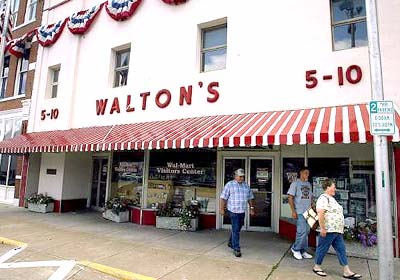Is helping Wal Mart better fit their stores into traditional Main Streets just like helping design context-sensitive concentration camps?
In "Wal-Mart considers new look for Pass [Christian]," the Biloxi Herald reports, with the intercession of new urbanists in Mississippi working on the Mississippi Renewal project, that:
Wal-Mart has agreed to discuss an unconventional plan for rebuilding its Pass Christian store...
The redevelopment team envisions a two-story building with Wal-Mart on the ground floor and spaces on top for other businesses. Hall has said previously the facade could be built in the style of the community. A mixed commercial and residential Wal-Mart Village, offering affordable housing and narrow, walkable streets, could be built up around it. Hall said the suggestion for Pass Christian's Wal-Mart could be the wave of the future. The store's rebuilding would be a boost to the city that would help it recapture some of its tax base.
________
This is a correction to the article from a CNU member:
Andres and I had a phone conference with the executives in Wal-Mart's Real Estate and Design division in October. They were very receptive to ideas for a new urban form for Wal-Mart (specifically for Pass Christian), and invited the New Urbanists to Bentonville to discuss it.
A tentative date of Jan. 16th has been set for this meeting. Those attending may include Andres, Victor Dover, Bob Gibbs, Ben Pentreath (architect from Prince of Wales Foundation who drew the urban Wal-Mart sketches for Pass Christian at the Gulf Coast Charrette), Jim Barksdale, Malcolm Jones (Pass Christian acting Mayor) and myself.
________________
The issue isn't the design, and fitting a big box into a traditional Main Street. After all, more than 100 years ago big department stores figured out how to "fit a big box" onto-into pedestrian-centered shopping streets. The issue is what choices do you make for building, or not building, a local economy.
Despite the success of sprawl around Bentonville, Arkansas and the arrival of luxury shops catering to Wal Mart executives and the supplier companies located in the area, downtown Bentonville is distressed, at least according to this report in the Baltimore Sun "Under the giant's shadow; Bentonville: Another side of Sam Walton's huge success is revealed in the Arkansas town where he first got the idea that revolutionized retailing" from April 16th, 2002. From the article:
But a look at Bentonville today displays another side of Walton's huge success. Today, the downtown five-and-dime that gave Walton his start is a museum piece, carefully preserved as the Wal-Mart Visitors Center. As in small towns across the nation, the kinds of businesses that give a downtown life have moved out - joining the Wal-Mart on the edge of town. Half a century ago, no one thought that possible - either that big discount stores could thrive in the countryside or that little downtowns would wither.
From the looks of Bentonville, still a town of less than 50,000 people, exactly the opposite is true today. An immense Wal-Mart Supercenter thrives on Sam Walton Boulevard, the commercial strip on the edge of town, along with dozens of fast-food restaurants, gas stations, convenience stores and strip malls as far as the eye can see. But to those who have tried to do business in downtown Bentonville in recent years, the idea of succeeding in the age of Wal-Mart with a store like Walton's five-and-dime is a sick joke.
 Exterior of Walton's Five-and-Dime, a Wal-Mart museum and tourist attraction. It is the site of Sam Walton's first store in Bentonville, Ark. (Brian VanderBrug / Los Angeles Times) September 15, 2003
Exterior of Walton's Five-and-Dime, a Wal-Mart museum and tourist attraction. It is the site of Sam Walton's first store in Bentonville, Ark. (Brian VanderBrug / Los Angeles Times) September 15, 2003"Sam Walton? Nope, he'd never make it," says Ken Wenzinger, whose videostore/second-hand clothing shop on Main Street closed after a year. "There's just not enough traffic to get business going downtown." Wal-Mart is widely vilified for destroying downtown business districts from one end of the nation to the other. Whether Wal-Mart is truly to blame, orother forces joined in, Bentonville's business district hasn't escaped the fate.
On the square, an office supply company is still in business, as are a touristy knick knack store and a cafe next to Walton's old five-and-dime. But that's about it. Bentonville Furniture Inc., which once boasted "four floors of fine furniture," has been gutted. The shoe repair shop is gone, as is the doughnut shop. The dry cleaner closed. Western Auto closed. Even the post office has moved to Walton Boulevard...



0 Comments:
Post a Comment
<< Home